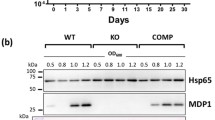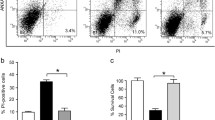Abstract
When stressed, bacteria can enter various nondividing states. In the present study, nondividing filamentous form in Helicobacter pylori was induced by a β-lactam antibiotic, aztreonam. In order to find possible cell division checkpoints in H. pylori, 2-DE was used to compare the proteomic profile of nondividing filamentous H. pylori with its spiral form. In total, 21 proteins involved in various cellular processes showed differential expression. One protein induced by aztreonam was a cell division inhibitor (minD), related to cell division. We then constructed the deletion mutant of minD in H. pylori 26695. Scanning electron microscope observation showed that the deletion of this protein provoked some bacteria to change into a short rod-shape and the viability of the mutant is lower than that of the wild type. Moreover, sequence comparison showed that minD of H. pylori and that of Escherichia coli share 50 % amino acid identity. This suggested that this protein possibly plays the similar part in H. pylori as in E. coli.





Similar content being viewed by others
References
McAtee CP, Hoffman PS, Berg DE (2001) Identification of differentially regulated proteins in metronidazole resistant Helicobacter pylori by proteome techniques. Proteomics 1:516–521. doi:10.1002/1615-9861(200104
Takeuchi H, Shirai M, Akada JK, Tsuda M, Nakazawa T (1998) Nucleotide sequence and characterization of cdrA, a cell division-related gene of Helicobacter pylori. J Bacteriol 180:5263–5268
Horii T, Mase K, Suzuki Y, Kimura T, Ohta M, Maekawa M, Kanno T, Kobayashi M (2002) Antibacterial activities of beta-lactamase inhibitors associated with morphological changes of cell wall in Helicobacter pylori. Helicobacter 7:39–45. doi:10.1046/j.1523-5378.2002.00054.x
DeLoney CR, Schiller NL (1999) Competition of various beta-lactam antibiotics for the major penicillin-binding proteins of Helicobacter pylori: antibacterial activity and effects on bacterial morphology. Antimicrob Agents Chemother 43:2702–2709
Keep NH, Ward JM, Cohen-Gonsaud M, Henderson B (2006) Wake up! Peptidoglycan lysis and bacterial non-growth states. Trends Microbiol 14:271–276. doi:10.1016/j.tim.2006.04.003
Errington J, Daniel RA, Scheffers DJ (2003) Cytokinesis in bacteria. Microbiol Mol Biol Rev 67:52–65. doi:10.1128/MMBR.67.1.52-65.2003
Arends SJ, Weiss DS (2004) Inhibiting cell division in Escherichia coli has little if any effect on gene expression. J Bacteriol 186:880–884. doi:10.1128/JB.186.3.880-884.2004
Krishnamurthy P, Parlow MH, Schneider J, Burroughs S, Wickland C, Vakil NB, Dunn BE, Phadnis SH (1999) Identification of a novel penicillin-binding protein from Helicobacter pylori. J Bacteriol 181:5107–5110
Shao C, Zhang Q, Sun Y, Liu Z, Zeng J, Zhou Y, Yu X, Jia J (2008) Helicobacter pylori protein response to human bile stress. J Med Microbiol 57:151–158. doi:10.1099/jmm.0.47616-0
Loughlin MF, Barnard FM, Jenkins D, Sharples GJ, Jenks PJ (2003) Helicobacter pylori mutants defective in RuvC Holliday junction resolvase display reduced macrophage survival and spontaneous clearance from the murine gastric mucosa. Infect Immun 71:2022–2031. doi:10.1128/IAI.71.4.2022-2031.2003
Kim JS, Chang JH, Chung SI, Yum JS (1999) Molecular cloning and characterization of the Helicobacter pylori fliD gene, an essential factor in flagellar structure and motility. J Bacteriol 181:6969–6976
Popham DL, Young KD (2003) Role of penicillin-binding proteins in bacterial cell morphogenesis. Curr Opin Microbiol 6:594–599. doi:10.1016/j.mib.2003.10.002
Spohn G, Scarlato V (1999) The autoregulatory HspR repressor protein governs chaperone gene transcription in Helicobacter pylori. Mol Microbiol 34:663–674. doi:10.1046/j.1365-2958.1999.01625.x
Sánchez B, Champomier-Vergès MC, Anglade P, Baraige F, de Los Reyes-Gavilán CG, Margolles A, Zagorec M (2005) Proteomic analysis of global changes in protein expression during bile salt exposure of Bifidobacterium longum NCIMB 8809. J Bacteriol 187:5799–5808. doi:10.1128/JB.187.16.5799-5808.2005
Shao C, Zhang Q, Tang W, Qu W, Zhou Y, Sun Y, Yu H, Jia J (2008) The changes of proteomes components of Helicobacter pylori in response to acid stress without urea. J Microbiol 46:331–337. doi:10.1007/s12275-008-0062-x
Seyler RW, Olson JW, Maier RJ (2001) Superoxide dismutase-deficient mutants of Helicobacter pylori are hypersensitive to oxidative stress and defective in host colonization. Infect Immun 69:4034–4040. doi:10.1128/IAI.69.6.4034-4040.2001
Kim MK, Song HE, Kim YS, Rho SH, Im YJ, Lee JH, Kang GB, Eom SH (2003) Crystallization and preliminary X-ray crystallographic analysis of orotate phosphoribosyl transferase from Helicobacter pylori. Mol Cells 15:361–363
Cordell SC, Löwe J (2001) Crystal structure of the bacterial cell division regulator MinD. FEBS Lett 492:160–165. doi:10.1016/S0014-5793(01)02216-5
Harry EJ, Lewis PJ (2003) Early targeting of Min proteins to the cell poles in germinated spores of Bacillus subtilis: evidence for division apparatus-independent recruitment of Min proteins to the division site. Mol Microbiol 47:37–48. doi:10.1046/j.1365-2958.2003.03253.x
Karoui ME, Errington J (2001) Isolation and characterization of topological specificity mutants of minD in Bacillus subtilis. Mol Microbiol 42:1211–1221. doi:10.1046/j.1365-2958.2001.02710.x
Pichoff S, Lutkenhaus J (2001) Escherichia coli division inhibitor MinCD blocks septation by preventing Z-ring formation. J Bacteriol 183:6630–6635. doi:10.1128/JB.183.22.6630-6635.2001
Acknowledgments
This work was supported by the National Natural Science Foundation of China (No: 30770118, 30972775, 30800037, 30800406, 81071313, 81001098, 81000868, and 30971151) and the Science Foundation of Shandong Province, PR China (No: ZR2009CZ001 and ZR2009CM002). We gratefully acknowledge the invaluable help of Jissica Link for critically reading this manuscript.
Author information
Authors and Affiliations
Corresponding author
Additional information
Chunhong Shao and Yabin Zhou contributed equally to this work.
Rights and permissions
About this article
Cite this article
Shao, C., Zhou, Y., Sun, Y. et al. Analysis of Aztreonam-Inducing Proteome Changes in Nondividing Filamentous Helicobacter pylori . Curr Microbiol 65, 108–115 (2012). https://doi.org/10.1007/s00284-012-0132-5
Received:
Accepted:
Published:
Issue Date:
DOI: https://doi.org/10.1007/s00284-012-0132-5




